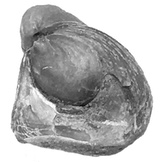Lithofacies of the type Cincinnatian Series

Although other facies occur in the type Cincinnatian Series, four facies dominate the section in the Cincinnati area of northernmost Kentucky, Ohio, and Indiana. These four facies are the peritidal, shallow subtidal, deep subtidal, and offshore. The Cincinnati area was a gently northward-dipping ramp during the late Ordovician, such that at any given time, shallower-water environments were present to the south and deeper-water environments were present to the north. Furthermore, this ramp tended to build northward repeatedly through time, such that these facies recur in vertical shallowing-upward successions. Although different authors have referred to these facies by different names, these same facies have been recognized by Hay (1981), Tobin (1981, 1986), Weir et al. (1984), and Holland (1993).
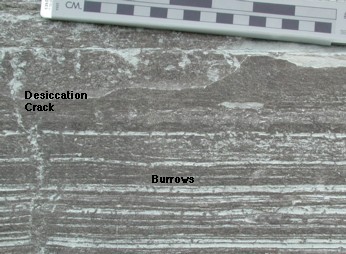
Peritidal facies consist of laminated to bioturbated argillaceous dolomite and dolomitic limestone that are largely unfossiliferous or carry a sparse fauna which commonly contains bryozoans, but may also contain ostracods, brachiopods, and a stromatoporoid - rugosan - tabulate assemblage. Desiccation cracks, vortex ripples, short vertical burrows (visible at left), glauconite, and intraclastic lags are all common. This facies can also be highly bioturbated, with correspondingly rarer planar lamination and desiccation cracks. This facies is typified by the massive Saluda Dolomite, as found near Madison, Indiana, as well as the Rowland, Terrill, Tate, and Garrard of central Kentucky. This facies is interpreted to represent deposition in shallowest subtidal, intertidal, and supratidal settings.
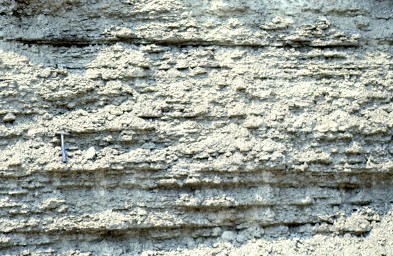
Shallow subtidal facies include nodular to wavy, very thin-bedded (1–3 cm) skeletal packstone and grainstone separated by abundant partings and very thin beds of fossiliferous mudstone. This facies commonly weathers to a characteristic rubble. Bioturbation is pervasive and has given rise to the nodular to wavy bedding. This facies contains a fauna dominated by the thick-shelled brachiopods Vinlandostrophia, Hebertella, and Rafinesquina, as well as abundant thick ramose and massive bryozoans. Many of the fossils are highly broken and abraded. The shallow subtidal facies may be conformably overlain by peritidal facies. The Bellevue Member is predominantly shallow subtidal facies, as are the Mount Auburn, Oregonia, and Whitewater Formations. The shallow subtidal facies is interpreted to reflect deposition below mean low tide, but largely above fair-weather wavebase.

Deep subtidal facies are characterized by thin bedded to medium bedded (3–30 cm) tabular to skeletal packstone and grainstone, separated by nearly equally thick beds of mudstone, all deposited as storm beds. This facies may also contain thick beds of calcisiltite with planar lamination and hummocky cross-lamination. The deep subtidal facies is very fossiliferous and contains a diverse assemblage dominated by brachiopods and bryozoans, most of which are intermediate in thickness and taphonomic degradation between the shallow subtidal facies and offshore facies. Common trace fossils include Chondrites, Diplocraterion, Trichophycus, and Palaeophycus. The deep subtidal facies may be conformably overlain by shallow subtidal facies. The Fairview Formation is mainly deep subtidal facies, as are the Corryville, Sunset (in Ohio), and Liberty Formations. The deep subtidal facies is interpreted to reflect deposition between fair-weather and storm wave base.
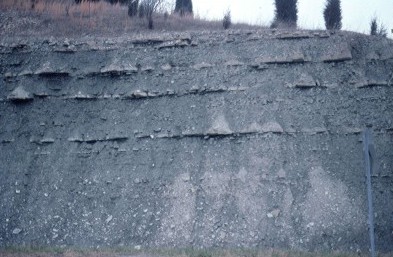
Offshore facies are typified by mudstone-dominated intervals that contain very thin to thin beds (1–10 cm) of skeletal grainstone, packstone, and calcisiltite, all deposited as storm beds. Hummocky cross-lamination, planar lamination, and wave-ripple lamination are all common in calcisiltite beds, as are gutter casts and tool marks on the bases of those beds. Many crinoidal grainstones have prominent megaripples and large-scale (i.e., sets > 5 cm in thickness) unidirectional cross-beds. This facies is dominated by relatively small and fragile brachiopods such as Dalmanella and Sowerbyella, by trilobites such as Flexicalymene, Gravicalymene, and Cryptolithus, and by small ramose bryozoans, although a wide variety of molluscs and crinoids can also be common. Preservation of fragile forms prone to disarticulation is commonly very good, and breakage and abrasion are generally minor. Common trace fossils include Chondrites, Diplocraterion, Trichophycus, Rusophycus and Palaeophycus. The offshore facies may be conformably overlain by deep subtidal facies. The Kope and Waynesville Formations are both predominantly offshore facies. The offshore facies is interpreted to reflect deposition below the wave base of most storms, but was affected by the strongest storms.
Other Cincinnatian Lithofacies
Several other lithofacies also occur in the Cincinnatian, but tend to be much thinner, comprise a much smaller proportion of the stratigraphy, and be much more geographically restricted than the four main facies of the Cincinnatian. These other facies tend to be restricted to the basal transgressive systems tracts of each sequence (see 3rd-order sequences).
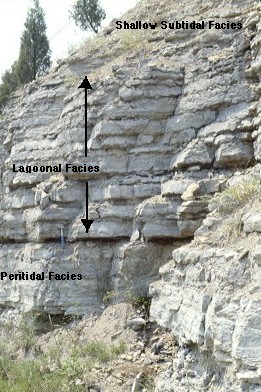
Lagoonal facies represent limestone-dominated intervals characterized by medium-bedded (10–30 cm) wackestone and lime mudstone, separated by thin partings of terrigenous mudstone. Terrigenous mudstone makes up a much smaller proportion of this facies than most type Cincinnatian lithofacies. Normal grading, planar lamination, and bioturbation are all common. Bedding in this facies is characterized by tabular beds with wavy tops and bottoms. This facies is distinctive in that in addition to the typical shallow marine fauna dominated by the brachiopods Vinlandostrophia and Hebertella, this facies commonly also contains diverse and well-preserved molluscs, ostracods, and corals. Lagoonal facies are represented by the Saluda Formation, as exposed near Brookville, Indiana, as well as by the Sunset and Gilbert of south-central Kentucky. The lagoonal facies is interpreted to be deposited in depths similar to the shallow subtidal facies, but was protected to the north (oceanward) by a belt of carbonate sand shoals, now preserved as crossbedded crinoidal-bryozoan grainstones. The lagoonal facies is developed only in the basal transgressive systems tract of the C3, C4, and C6 sequences.
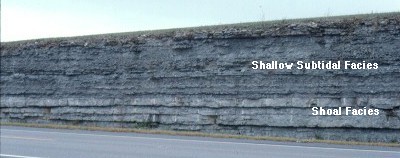
Shoal facies are characterized by cross-bedded, medium to thick bedded (10–100 cm) calcarenites or crinoidal-bryozoan grainstones. Some beds may separated by fossiliferous argillaceous mudstones. This facies is commonly more resistant and shale-poor than surrounding facies, causing it to be quite prominent in outcrops (see photo at left). The cross-beds consist of large-scale (sets greater than 5 cm thick) trough and tabular cross-beds. Fossils include shallow subtidal forms such as Vinlandostrophia, Hebertella, and robust bryozoans, but bioclasts are commonly highly broken, abraded, bored, and encrusted. Robust and abraded bryozoans are commonly concentrated along the toes of foresets. The shoal facies is commonly mapped with surrounding or adjacent shallow subtidal facies. The shoal facies is generally present across central and northern Kentucky (rarely northward); where it is developed, lagoonal facies are commonly present landward to the south in central Kentucky. Hence, the shoal facies is interpreted to represent a series of barrier islands, tidal inlets, and tidal deltas that protected a relatively quiet water but fully marine lagoon to the south. Shoal facies are known from the basal portions of the C3, C4, C5, and C6 transgressive systems tracts.
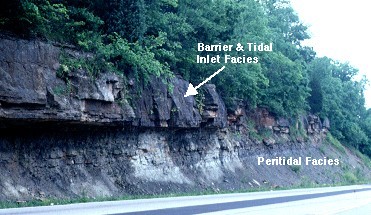
Barrier and tidal inlet facies are present only at the base of the C5 transgressive systems tract in a several square mile area near Bedford, Kentucky. Mapping of this facies suggests that it represents a barrier island and associated tidal inlets. The facies consists of roughly equal proportions of gastropod (Paupospira) coquinas and crinoidal grainstones. Bedding is medium to thick (10–100 cm), and remnants of cross-laminae are common. The gastropods are remarkably well-preserved and display only limited breakage. Burrows are present, with Skolithos-like vertical burrows being the most common types. This facies, represented by the Marble Hill Bed (shown at left) is much more resistant than the surrounding shalier units, which cause it to weather prominently to a cliff.
